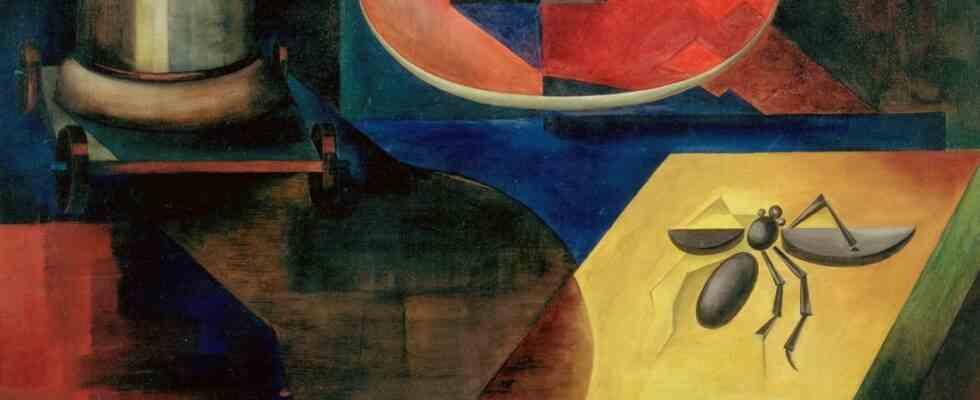Whoever enters the exhibition rooms is first confronted with the obligatory curriculum vitae. Hannah Höch, Greek profile, bob haircut, led an eventful life: soloist among Berlin’s Dada alpha men; Liaison with the married Raoul Hausmann, who taught her from above how she could find herself. Seeking unlimited freedom, Höch separated and lived with Dutch translator and author Til Brugman for almost a decade.
Until the Nazis imposed an exhibition ban on them in 1937. At first she traveled restlessly with her new husband Kurt Matthies in the caravan before she divorced and retired to her garden realm in Berlin-Heiligensee. Soon after the end of the war, she was celebrated around the world, above all as the grand old lady of the Berlin Dada movement. Her early photo collage “Cut with the Dada kitchen knife through the last Weimar beer belly cultural epoch in Germany” was regarded as style-defining.
A self-portrait by Hannah Höch from 1917.
(Photo: VG Bild-Kunst, Bonn 2022/Berliner Sparkasse)
Art history thus found a comfortable drawer for Höch, who died in Berlin in 1978 at the age of 88. The fact that this restriction does not do justice to her many artistic facets is now impressively shown in the exhibition “Hannah Höch. Millions and millions of views” curated by Ellen Maurer Zilioli. It is not difficult to find borrowings from the many -isms of modernity in her extremely vital works: Expressionism, Dadaism, Futurism, Constructivism and finally Surrealism. But Maurer Zilioli sees Höch’s genuine achievement precisely in this “calculated vagabondage within modernity”.
The exhibition of around 120 paintings, collages, watercolors and drawings from all creative phases, which was previously on display in Berlin’s Bröhan Museum, has migrated to the Museum im Kulturspeicher Würzburg for the summer months. Its title refers to a programmatic text in lower case that Höch wrote for her first solo exhibition in The Hague in 1929 and that was projected onto one of the walls. She sees herself as a seer and wants “there are millions and millions of legitimate other views besides yours and mine”.
A matter of perspective
The curriculum vitae at the beginning of the exhibition was loosened up with photos, one of which is particularly striking. It shows an elderly Hannah Höch looking straight into the camera, holding a magnifying glass in front of her eye. As a result, it is magnified to gigantic proportions: a wonderfully surreal effect. If you turn a little to the right from here, you will see the first picture wall and the collage “Owl with a magnifying glass”.
A collage that leaves room for interpretation: “Owl with a magnifying glass” from 1945.
(Photo: VG Bild-Kunst, Bonn 2022)
The sheet, created around the end of the Second World War, shows the bird of prey sitting on an airy cloud and looking down at the earth through a magnifying glass in its claws. He seems to see through humanity. The bird’s-eye view is taken quite literally here. The animal commonly stands for wisdom, but it has always been able to symbolize misfortune and death. The collage leaves room for interpretation. A further passage from Höch’s above-mentioned text fits in with this: “I would like to demonstrate to the world today how a bee sees it and tomorrow how the moon sees it, and then how many other creatures may see it.”
After this stupendous prelude, the show shows that Hannah Höch struggled throughout her artistic life to look at the world from every imaginable angle. This polyfocality is reflected in the exhibition architecture. Walls of different colors were drawn into the two spacious rooms, some of which stand diagonally like bars. In doing so, they take up the variety of forms in the pictures from Höch’s work, known as “Abstract Compositions” and “Symbolic Landscapes”.
Hannah Höch’s “Symbolic Landscape III” from 1930 reflects the variety of forms in her work.
(Photo: VG Bild-Kunst, Bonn 2022)
She appears like a researcher who wants to penetrate step by step deeper into the microcosm as well as the macrocosm. Turning to the visible-objective in order to then try to also bring the invisible to light. Not only does she portray herself throughout her life, but she also paints flowers on and off. Unlike animals and people, plants are only beautiful to them. However, if they hang their heads like in the dark watercolor “Seherin” from 1940, this must be understood as a comment on the time. With her interest in the universe, which appears in the collage “Composition with Universe and Eye” that was created at the same time, she is far ahead of her time. Further interstellar visions followed in the 1950s.
“Rome, 1921”, a watercolor by Hannah Höch.
(Photo: VG Bild-Kunst, Bonn 2022)
The hanging of the works follows the course of life only initially. Then the chronology is broken up, early next to late. This allows techniques and motifs to be identified that Höch has consistently applied or taken up. Born in Gotha in 1889, the artist first studied at the Berlin-Charlottenburg arts and crafts school and from 1915 at the arts and crafts museum. She should never completely give up her penchant for patterns and ornaments. Not to mention the collage technique that was subsequently developed.
As for the motifs: in addition to the flowers, eyes, moon and mask faces regularly appear. Her peculiarity of draping figures on plinths and plateaus, thus giving the pictures a surreal impression, is already evident on the sheet “Preparatory Drawing for a Painting” from 1921. “I have never looked at things from just one side. I am always got around things,” she once said. Visitors should take this to heart as they tour.
Hannah Hoch. millions upon millions of notions. Museum in the Würzburg cultural storehouse, until September 4th. Catalog (Wienand Verlag) 28 euros.

